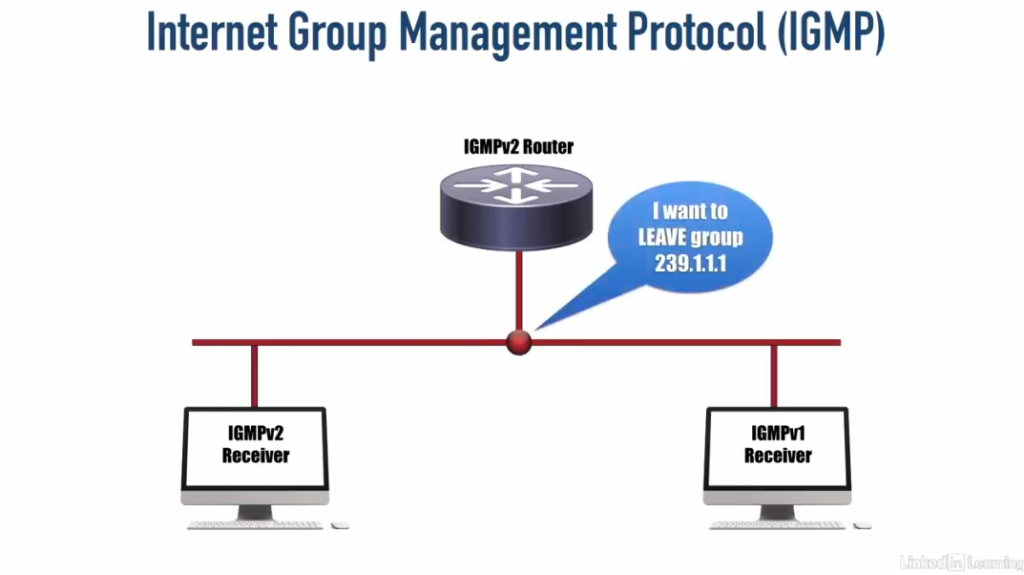Lesson 1: Multicast Fundamentals, Addressing, and IGMP
This lesson covers the essentials of multicast networking, focusing on multicast fundamentals, IP multicast addressing, and the Internet Group Management Protocol (IGMP), which enables hosts to join multicast groups. We’ll explore IGMPv2 and IGMPv3, message formats, and multicast address allocations, setting the foundation for effective multicast deployment and management in a network.
1. 🌍 Multicast Fundamentals
Multicast communication is designed to optimize network resources by allowing a single source to send data to multiple destinations. This model is ideal for applications like video streaming, online gaming, and real-time financial data distribution.
Key Concepts:
- Multicast Traffic Flow: Unlike unicast (one-to-one) or broadcast (one-to-all), multicast is a one-to-many or many-to-many model. A single data stream from a source is directed to multiple recipients without duplicating the stream, which conserves bandwidth.
- Multicast Group: Devices that want to receive multicast data must join a multicast group. Each group is identified by a unique multicast IP address, allowing routers to direct multicast traffic only to devices that request it.
- Benefits of Multicast:
- Efficient bandwidth utilization.
- Reduced server and network load.
- Optimized for streaming and real-time applications.
2. 🧭 IP Multicast Addresses Assigned by IANA
Multicast IP addresses fall within a specific range defined by IANA. These addresses are reserved for multicast traffic and identify multicast groups, allowing routers to recognize and manage multicast traffic efficiently.
Multicast IP Address Ranges:
- 224.0.0.0/4: The full multicast IP range.
- 224.0.0.0 to 224.0.0.255: Reserved for local network protocols and not routable beyond the local network. Examples include:
- 224.0.0.1: All hosts on a local subnet.
- 224.0.0.2: All routers on a local subnet.
- 224.0.0.5: OSPF routers.
- 224.0.0.6: OSPF designated routers.
- 224.0.1.0 to 238.255.255.255: Routable multicast addresses for global applications, such as video streaming or real-time data distribution.
- 239.0.0.0 to 239.255.255.255: Known as Administratively Scoped Addresses or private multicast addresses, similar to private IP ranges in unicast. These are used within private networks.
3. 🗂 Well-Known Reserved Multicast Addresses
Certain multicast addresses are reserved for specific functions, particularly in networking protocols. These are used to support standardized services and ensure compatibility across devices.
Examples:
- 224.0.0.1: All systems on the local subnet.
- 224.0.0.2: All routers on the local subnet.
- 224.0.0.5: OSPF routers.
- 224.0.0.6: OSPF designated routers.
- 224.0.0.9: RIP (Routing Information Protocol) routers.
4. 🛠️ Layer 2 Multicast Addresses
At the Layer 2 level, multicast traffic uses specific MAC addresses to ensure the correct delivery of packets. IP multicast addresses map to a range of multicast MAC addresses. For IPv4, multicast MAC addresses start with 01:00:5E, and bit 24 always 0 , with the remaining 23 bits corresponding to the multicast IP address.
Mapping Example:
An IP address of 224.0.0.5 maps to the MAC address 01:00:5E:00:00:05.

5. 🔍 Internet Group Management Protocol (IGMP) Overview
IGMP enables devices to join or leave multicast groups and allows routers to manage multicast group memberships. IGMP plays a critical role in ensuring that multicast traffic only reaches devices that have requested it.

Key Versions:
- IGMPv1: The initial version with basic group membership functionality.
- IGMPv2: Adds the ability for hosts to leave a group explicitly and improves efficiency for group membership maintenance.
- IGMPv3: Introduces support for source-specific multicast (SSM), allowing hosts to join multicast groups from specific sources.
6. 📜 IGMPv2
IGMPv2 enhances group management capabilities by allowing hosts to explicitly leave groups, making multicast group maintenance more efficient. Routers periodically query for group memberships to ensure only active members receive multicast traffic.
IGMPv2 Message Types:
- Membership Query: Sent by routers to determine active members of a multicast group.
- Membership Report: Sent by hosts to join a multicast group or indicate continued interest.
- Leave Group: Sent by hosts to leave a multicast group .

7. 📝 IGMPv2 Operation
IGMPv2 enables routers to track and manage multicast group membership. Here’s an outline of its operations:
- Joining a Group: When a host wants to join a multicast group, it sends a Membership Report to the router.
- Periodic Queries: Routers periodically send Membership Query messages to confirm which hosts are still members of a multicast group.
- Leaving a Group: When a host no longer wants to receive multicast traffic, it sends a Leave Group message, prompting the router to check if any other hosts are still members.
8. 🆕 IGMPv3
IGMPv3 introduces Source-Specific Multicast (SSM), allowing hosts to specify the exact source from which they want to receive traffic. This improves efficiency and security by narrowing multicast traffic to specific sources rather than accepting traffic from all sources within a group.
IGMPv3 Enhancements:
- Source Filtering: Hosts can specify which sources they want to accept or block within a multicast group. Include mode or exclude mode
- Improved Group Control: IGMPv3 includes commands to filter sources, increasing control over multicast traffic.
9. 👀 IGMP Snooping
IGMP Snooping is a feature used by Layer 2 switches to monitor IGMP traffic between hosts and routers, allowing switches to track which devices are members of which multicast groups. This helps optimize multicast traffic within a VLAN.

How IGMP Snooping Works:
- Membership Tracking: Switches track which hosts are interested in specific multicast groups by monitoring IGMP messages.
- Traffic Optimization: Instead of flooding multicast traffic to all ports in a VLAN, the switch forwards it only to the ports where interested hosts are connected.
Summary
In this lesson, we covered the fundamentals of multicast, including IP addressing, multicast group management, and the different versions of IGMP. Understanding these concepts is essential for configuring and optimizing multicast in a network. With IGMP and multicast addressing, you can ensure efficient and secure multicast traffic distribution.

